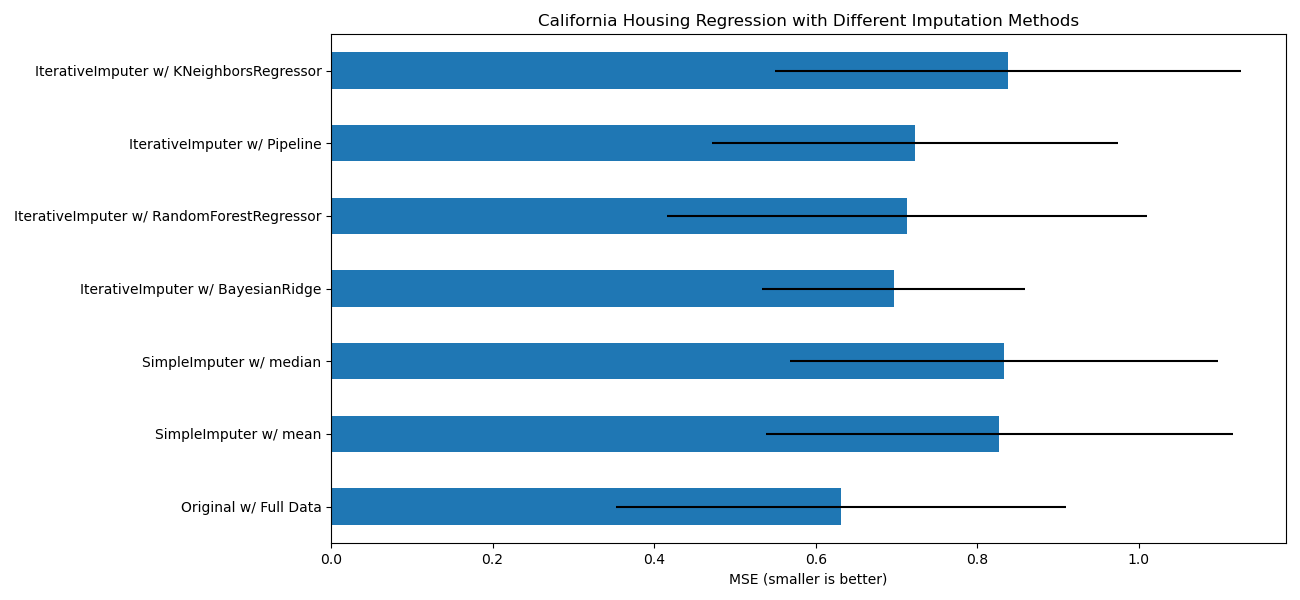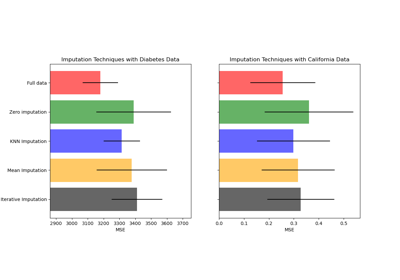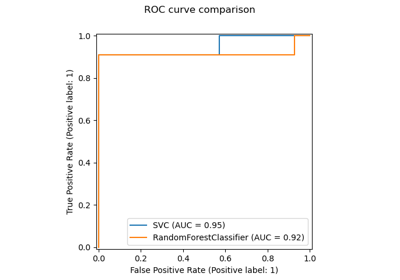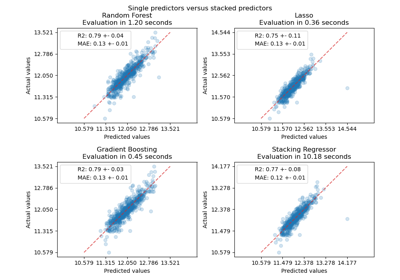注意
前往結尾以下載完整的範例程式碼。或透過 JupyterLite 或 Binder 在您的瀏覽器中執行此範例
使用 IterativeImputer 的變體填補遺失值#
IterativeImputer 類別非常靈活 - 它可以與各種估計器一起使用,以進行循環迴歸,將每個變數依次視為輸出。
在此範例中,我們比較了一些估計器,用於使用 IterativeImputer 進行遺失特徵填補
BayesianRidge:正規化線性迴歸RandomForestRegressor:隨機樹迴歸森林make_pipeline(Nystroem,Ridge):具有 2 次多項式核心擴展和正規化線性迴歸的管道KNeighborsRegressor:與其他 KNN 填補方法相當
特別令人感興趣的是 IterativeImputer 模仿 missForest 行為的能力,missForest 是 R 的熱門填補套件。
請注意,KNeighborsRegressor 與 KNN 填補不同,後者透過使用考慮遺失值的距離度量,從具有遺失值的樣本中學習,而不是填補它們。
目標是比較不同的估計器,看看哪一個最適合 IterativeImputer,在每個列隨機刪除一個值的加州房屋資料集上使用 BayesianRidge 估計器時。
對於這種特定的遺失值模式,我們看到 BayesianRidge 和 RandomForestRegressor 給出最好的結果。
應該注意的是,一些估計器(例如 HistGradientBoostingRegressor)可以原生處理遺失特徵,並且通常建議使用它們,而不是建構具有複雜且成本高昂的遺失值填補策略的管道。

# Authors: The scikit-learn developers
# SPDX-License-Identifier: BSD-3-Clause
import matplotlib.pyplot as plt
import numpy as np
import pandas as pd
from sklearn.datasets import fetch_california_housing
from sklearn.ensemble import RandomForestRegressor
# To use this experimental feature, we need to explicitly ask for it:
from sklearn.experimental import enable_iterative_imputer # noqa
from sklearn.impute import IterativeImputer, SimpleImputer
from sklearn.kernel_approximation import Nystroem
from sklearn.linear_model import BayesianRidge, Ridge
from sklearn.model_selection import cross_val_score
from sklearn.neighbors import KNeighborsRegressor
from sklearn.pipeline import make_pipeline
N_SPLITS = 5
rng = np.random.RandomState(0)
X_full, y_full = fetch_california_housing(return_X_y=True)
# ~2k samples is enough for the purpose of the example.
# Remove the following two lines for a slower run with different error bars.
X_full = X_full[::10]
y_full = y_full[::10]
n_samples, n_features = X_full.shape
# Estimate the score on the entire dataset, with no missing values
br_estimator = BayesianRidge()
score_full_data = pd.DataFrame(
cross_val_score(
br_estimator, X_full, y_full, scoring="neg_mean_squared_error", cv=N_SPLITS
),
columns=["Full Data"],
)
# Add a single missing value to each row
X_missing = X_full.copy()
y_missing = y_full
missing_samples = np.arange(n_samples)
missing_features = rng.choice(n_features, n_samples, replace=True)
X_missing[missing_samples, missing_features] = np.nan
# Estimate the score after imputation (mean and median strategies)
score_simple_imputer = pd.DataFrame()
for strategy in ("mean", "median"):
estimator = make_pipeline(
SimpleImputer(missing_values=np.nan, strategy=strategy), br_estimator
)
score_simple_imputer[strategy] = cross_val_score(
estimator, X_missing, y_missing, scoring="neg_mean_squared_error", cv=N_SPLITS
)
# Estimate the score after iterative imputation of the missing values
# with different estimators
estimators = [
BayesianRidge(),
RandomForestRegressor(
# We tuned the hyperparameters of the RandomForestRegressor to get a good
# enough predictive performance for a restricted execution time.
n_estimators=4,
max_depth=10,
bootstrap=True,
max_samples=0.5,
n_jobs=2,
random_state=0,
),
make_pipeline(
Nystroem(kernel="polynomial", degree=2, random_state=0), Ridge(alpha=1e3)
),
KNeighborsRegressor(n_neighbors=15),
]
score_iterative_imputer = pd.DataFrame()
# iterative imputer is sensible to the tolerance and
# dependent on the estimator used internally.
# we tuned the tolerance to keep this example run with limited computational
# resources while not changing the results too much compared to keeping the
# stricter default value for the tolerance parameter.
tolerances = (1e-3, 1e-1, 1e-1, 1e-2)
for impute_estimator, tol in zip(estimators, tolerances):
estimator = make_pipeline(
IterativeImputer(
random_state=0, estimator=impute_estimator, max_iter=25, tol=tol
),
br_estimator,
)
score_iterative_imputer[impute_estimator.__class__.__name__] = cross_val_score(
estimator, X_missing, y_missing, scoring="neg_mean_squared_error", cv=N_SPLITS
)
scores = pd.concat(
[score_full_data, score_simple_imputer, score_iterative_imputer],
keys=["Original", "SimpleImputer", "IterativeImputer"],
axis=1,
)
# plot california housing results
fig, ax = plt.subplots(figsize=(13, 6))
means = -scores.mean()
errors = scores.std()
means.plot.barh(xerr=errors, ax=ax)
ax.set_title("California Housing Regression with Different Imputation Methods")
ax.set_xlabel("MSE (smaller is better)")
ax.set_yticks(np.arange(means.shape[0]))
ax.set_yticklabels([" w/ ".join(label) for label in means.index.tolist()])
plt.tight_layout(pad=1)
plt.show()
腳本的總運行時間:(0 分鐘 6.721 秒)
相關範例




